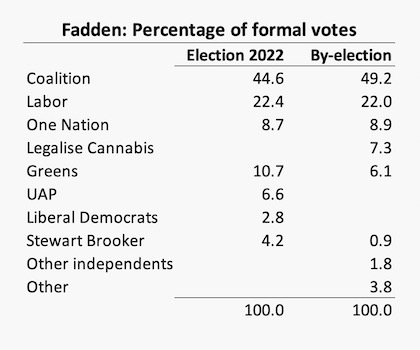Politics
Fadden by-election
Although national opinion polls are showing that support for Labor is up on last year’s election while support for the Coalition is down, the most credible interpretation of the Fadden by-election is that not much has changed in people’s vote over the last 14 months. The table below, drawn from the AEC count and 2022 results, shows the outcome of the by-election alongside last year’s election result.

At first sight that appears to be a 4.6 percent swing to the Coalition, but two parties on the far right – the UAP and the Liberal Democrats, about 65-75 percent of whose preferences normally flow to the Coalition – were not contesting the by-election, and there was no significant shift in support for One Nation. It looks as if that gain to the Coalition was from supporters of the UAP and the Liberal Democrats returning to the fold.[1]
The significant losers were the Greens, but one might wonder if they lost to the Legalise Cannabis Party – a single-issue party rather than a general libertarian party.
Still Labor should have done better. Adrian Beaumont, writing in The Conversation, points out that Labor is doing well in big cities, but not elsewhere. With a population of 625 000 – much larger than Canberra or Hobart – the Gold Coast can hardly be regarded as rural, however. But a glance at the ABS profile for the Gold Coastreveals that, in comparison with Australia as a whole, its level of tertiary education attainment is low, its cultural diversity is low, and “professionals” are under-represented in its employment base. That’s a profile of the Gold Coast as a whole: Fadden lies in the northern end of the Gold Coast, in the area of canal developments. It may be more an outer suburban electorate than an urban one.
These all help explain the Coalition’s strong support, but they do not explain why that support does not seem to have waned, or why, after preferences, there has been a two-party swing of about three percent to the Coalition.
The Coalition campaigned mainly on “cost of living”, not that they had any policies on offer to alleviate financial stress on households. Most commentators believe that the Robodebt findings didn’t help the Coalition, but perhaps it did, because with a fresh candidate replacing Stuart Roberts they could be seen to be putting Robodebt behind them. Also, in spite of it being a safe seat, the LNP spent heavily on the campaign – $600 000 by some estimates.
The general interpretation of the result is that it has given Peter Dutton breathing room. This removes incentives for the party to reform, and reinforces the idea that an election strategy of mindless negativity, economic twaddle, and fear is effective. It brings Australia no closer to the destruction or reconstruction of the federal Coalition.
1. In the 2022 election the UAP vote was 6.6 percent and the Liberal Democratic vote was 2.8 percent. According to the AEC, 64 percent of UAP votes and 73 percent of Liberal Democratic votes flowed to the Coalition through preferences. Applying these figures to the Fadden vote, it suggests that about 6.3 percent of voters in 2022 were voting for the Coalition through the UAP and the Liberal Democrats.↩
Voting intention polls
William Bowe’s Poll Bludger reports on the latest opinion polls from Newspoll and Resolve Strategic, both of which show Labor holding a commanding lead in two-party-preferred terms and in the primary vote. Primary voting intentions are shown below.

The Resolve Strategic poll asks respondents for their responses to two sets of views regarding the two main parties. One set related to four important policy headings, while the other is about political attributes.
Below are the Labor leads over the Coalition (specified as “The Liberals” in the survey.)
The first set asks “Which party you think would perform best in each of these areas … ”
Economic management – 4 percent
Security and defence – 3 percent
Healthcare and aged care – 20 percent
Education – 17 percent
The second set is “Statements that might describe a party best … ”
Are communicating well – 25 percent
Has a united team behind the leader – 31 percent
Is listening and focussing on the right issues –17 percent
Is offering strong leadership – 24 percent
Labor’s lead on economic management and security isn’t large, but historically the Coalition has almost always led strongly in terms of voter perception (even though their actual economic management was pitiful).
The poor result for “listening and focussing on the right issues” should be particularly concerning for the Coalition. They have been going hard on the cost of living, and the SEC Newgate Mood of the Nation pollconfirms that the cost of living is a major concern for almost everyone: 98 percent of respondents are concerned about grocery prices and a similar proportion are concerned about electricity bills, for example.
This suggests that the Coalition correctly understands that people are worried about the cost-of-living, but people don’t believe the Coalition has any policies that would address those concerns.